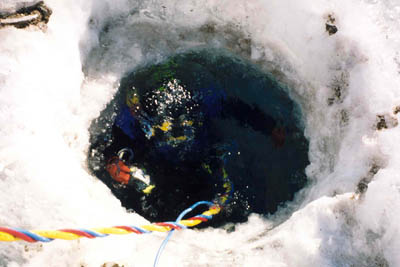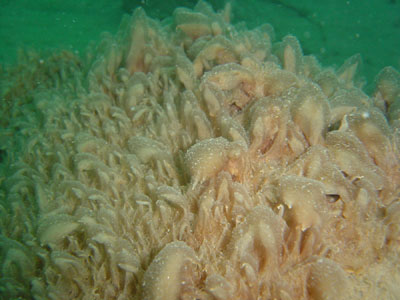Home|Glossary|Links|Journal|Maps
Science
 Donna
and Maria help Ian get ready for diving.
Donna
and Maria help Ian get ready for diving.
|
 Maria descends
into the hole
Maria descends
into the hole |
Click
on the photos to see a larger view
When
Ian Hawes, Donna Sutherland, and Maria Uhle said they were putting
on suits, they weren't heading to the office or going to a business
meeting. Instead, the three scientists were getting dressed in dive
gear known as dry suits and preparing to lower themselves into an
ice hole that was three feet in diameter, 15 feet long, and filled
with water that had an average temperature of 32 degrees Fahrenheit
(0 degrees Celsius).
The reason they did this was because
it was the only way they could get themselves below the permanent
ice that covered Lake Hoare in Taylor Valley, and they wanted to explore
the waters and life beneath it.
Ian and Donna, who are with New Zealand's
National Institute of Water and Atmospheric Research, and Maria, who
is with the University of Tennessee in Knoxville were this year's
Dry Valleys' (DV) dive team.
Their goal was to study photosynthesis
in low light environments. DV lakes are about as low as you can go
and still have photosynthesis take place.
Typically less than one percent of
the light that falls on the lakes makes it through the 15 to 20 feet
of ice that cover them, says Ian, who has been a part of the project
since its inception in 1994. But the bottom of Lake Hoare, report
the divers, is blanketed with several cm thick mats of organisms that
make the most of that wee bit of light. These bottom, or benthic dwellers,
include cyanobacteria and diatoms, which use light as an energy source
to convert carbon dioxide and water to carbohydrates in a process
known as photosynthesis. They also include protozoa and ordinary bacteria,
which are involved in the cycling of carbon and nutrients.
|

Maria gets a view of the lake ice from inside the dive
hole. Note the sediment trapped inside the ice.
|
Click
on the photo to see a larger view
Studying photosynthesis
in DV lakes is difficult because of the inherent problems of working
under thick ice cover. It is also hard because the rates of photosynthesis
are very low when compared to rates in temperate zones.
|
What
happens to the benthic mats
during the winter?

Benthic
Mats
The benthic
mats essentially enter a period of hibernation in which
their metabolism is reduced to maintenance levels. So
the mats gradually consume the carbon they fixed during
the summer, explains Donna.
Despite
this, the mats still manage to grow a few millimeters
each year. Yet if the DV lakes had insects or mollusks
that fed on the microbial mats, as is the case in many
other lakes, winter would be a time when the mats would
be depleted, notes Ian. But in DV lakes these consumers
are absent, and the microbial mats are free to slowly
accumulate to their spectacular formations. This is a
slow process as a 10 cm high benthic mat may have taken
many years to develop.Slow, undisturbed growth, coupled
with the efficient use of energy and internal cycling
of nutrients, is what allows the benthic mats to dominate
the DV lakes.
|
|
To address this latter problem,
the team made use of a new approach that measures photosynthesis
with a fluorometer. "Photosynthesis," explains Ian,
"is really just a flow of electrons." Fluorometers
measure that flow. "The amount of photosynthesis taking
place is pretty much directly proportional to the electron flow
measured."
Fluorometer analyses have shown
that DV lake cyanobacteria and diatoms are well-suited to the
very low light regime that they get, says Donna. Photosynthetic
organisms require a certain amount of light for their photosynthetic
systems to kick into gear and start operating. The threshold
for the DV lake cyanobacteria and diatoms is incredibly low.
This specialization has a cost, however - the DV organisms can't
use light at intensities much higher than 1% that of temperate
zone noonday sunlight. But that's not a problem, notes Ian.
They rarely receive more light than this.
Because DV lake cyanobacteria
and diatoms get such low amounts of light, they photosynthesize
at rates that are much slower than their temperate counterparts.
Yet says Donna, they are able to use that light very efficiently.
Scientists have been trying to figure out why.
They've found that it has a lot
to do with how well the organisms absorb light energy. The amount
and kind of light reaching the benthic mats is influenced by
their location at the bottom of a lake, an ice-covered one at
that. Water in general, and ice in particular, filter out wavelengths
of light at different rates. Colors associated with longer wavelengths,
such as red and yellow, are the first to be absorbed while colors
associated with shorter wavelengths, such as blue, are absorbed
last. So the little bit of light that does make it to the bottom
of Lake Hoare is blue.
Both the DV cyanobacteria and
the DV diatoms are very efficient at soaking up this blue light.
They have pigments that allow them to absorb around 80% of the
light that hits them. Of this light, an average 90% is converted
into the electrochemical reactions that comprise photosynthesis.
The pigments are an adaptation that helps the cyanobacteria
and diatoms survive and thrive in the Dry Valleys.
|
Photos courtesy of Karen Cozzetto
- Karen




